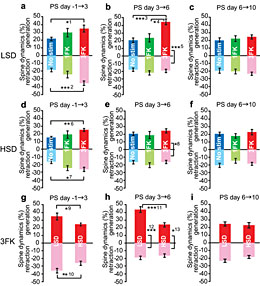Research Abstract
繰り返しLTP誘発後のシナプス新生における樹状突起棘の動態と既存棘密度依存性
Dendritic spine dynamics in synaptogenesis after repeated LTP inductions: Dependence on pre-existing spine density
2013年6月6日 Scientific Reports 3 : 1957 doi: 10.1038/srep01957

私たち自身の日常の体験からも、動物を用いた学習実験からも、長期記憶の成立に練習の繰り返しが必要なことは分かっている。しかし、こうした繰り返し依存的な記憶固定の背景にある細胞基盤は、ほとんど分かっていない。著者らは以前、齧歯類脳海馬の器官保存的な切片培養を用いて、LTP(長期増強現象)を繰り返し誘発すると、LTP自体とは別個なシナプス新生を伴うシナプス強化がゆっくりと発達し、長期間維持されることを報告し、この現象が繰り返し依存的な記憶固定の解析に適したモデル実験系になると提唱した。今回、繰り返しLTP誘発後に個々の樹状突起棘の動態を観察したところ、棘は2段階の確率論的過程を経て、結果的に棘密度の増大が起こることが分かった。また、この変化が、既存の棘密度が低い樹状突起のセグメントで優先的に起こることも分かった。これらの結果から、繰り返し依存的な記憶固定の細胞基盤を理解するための手掛かりが得られるかもしれない。
大江 祐樹1*, 冨永(吉野)恵子1, 長谷川 翔1 & 小倉 明彦1
- 大阪大学大学院 生命機能研究科 生命機能学専攻 脳神経工学講座 神経可塑性生理学研究室
*現所属先:理化学研究所 脳科学総合研究センター
Not only from our daily experience but from learning experiments in animals, we know that the establishment of long-lasting memory requires repeated practice. However, cellular backgrounds underlying this repetition-dependent consolidation of memory remain largely unclear. We reported previously using organotypic slice cultures of rodent hippocampus that the repeated inductions of LTP (long-term potentiation) lead to a slowly developing long-lasting synaptic enhancement accompanied by synaptogenesis distinct from LTP itself, and proposed this phenomenon as a model system suitable for the analysis of the repetition-dependent consolidation of memory. Here we examined the dynamics of individual dendritic spines after repeated LTP-inductions and found the existence of two phases in the spines' stochastic behavior that eventually lead to the increase in spine density. This spine dynamics occurred preferentially in the dendritic segments having low pre-existing spine density. Our results may provide clues for understanding the cellular bases underlying the repetition-dependent consolidation of memory.

